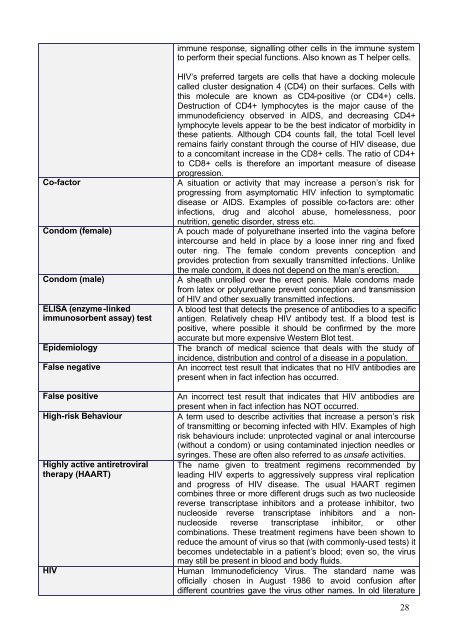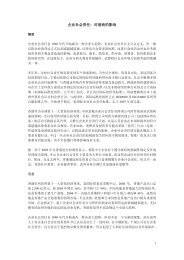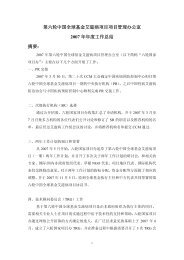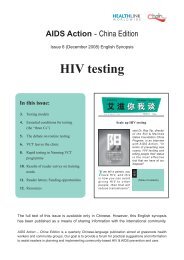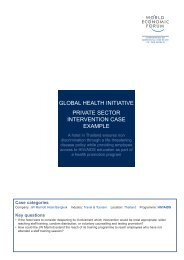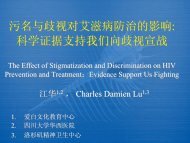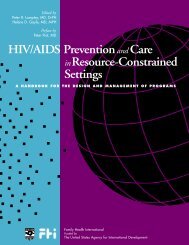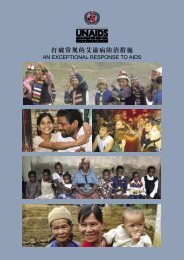What is HIV and AIDS?
What is HIV and AIDS?
What is HIV and AIDS?
Create successful ePaper yourself
Turn your PDF publications into a flip-book with our unique Google optimized e-Paper software.
immune response, signalling other cells in the immune system<br />
to perform their special functions. Also known as T helper cells.<br />
<strong>HIV</strong>’s preferred targets are cells that have a docking molecule<br />
called cluster designation 4 (CD4) on their surfaces. Cells with<br />
th<strong>is</strong> molecule are known as CD4-positive (or CD4+) cells.<br />
Destruction of CD4+ lymphocytes <strong>is</strong> the major cause of the<br />
immunodeficiency observed in <strong>AIDS</strong>, <strong>and</strong> decreasing CD4+<br />
lymphocyte levels appear to be the best indicator of morbidity in<br />
these patients. Although CD4 counts fall, the total T-cell level<br />
remains fairly constant through the course of <strong>HIV</strong> d<strong>is</strong>ease, due<br />
to a concomitant increase in the CD8+ cells. The ratio of CD4+<br />
to CD8+ cells <strong>is</strong> therefore an important measure of d<strong>is</strong>ease<br />
progression.<br />
Co-factor A situation or activity that may increase a person’s r<strong>is</strong>k for<br />
progressing from asymptomatic <strong>HIV</strong> infection to symptomatic<br />
d<strong>is</strong>ease or <strong>AIDS</strong>. Examples of possible co-factors are: other<br />
infections, drug <strong>and</strong> alcohol abuse, homelessness, poor<br />
nutrition, genetic d<strong>is</strong>order, stress etc.<br />
Condom (female) A pouch made of polyurethane inserted into the vagina before<br />
intercourse <strong>and</strong> held in place by a loose inner ring <strong>and</strong> fixed<br />
outer ring. The female condom prevents conception <strong>and</strong><br />
provides protection from sexually transmitted infections. Unlike<br />
the male condom, it does not depend on the man’s erection.<br />
Condom (male) A sheath unrolled over the erect pen<strong>is</strong>. Male condoms made<br />
from latex or polyurethane prevent conception <strong>and</strong> transm<strong>is</strong>sion<br />
ELISA (enzyme-linked<br />
immunosorbent assay) test<br />
of <strong>HIV</strong> <strong>and</strong> other sexually transmitted infections.<br />
A blood test that detects the presence of antibodies to a specific<br />
antigen. Relatively cheap <strong>HIV</strong> antibody test. If a blood test <strong>is</strong><br />
positive, where possible it should be confirmed by the more<br />
accurate but more expensive Western Blot test.<br />
Epidemiology The branch of medical science that deals with the study of<br />
incidence, d<strong>is</strong>tribution <strong>and</strong> control of a d<strong>is</strong>ease in a population.<br />
False negative<br />
An incorrect test result that indicates that no <strong>HIV</strong> antibodies are<br />
present when in fact infection has occurred.<br />
False positive<br />
An incorrect test result that indicates that <strong>HIV</strong> antibodies are<br />
present when in fact infection has NOT occurred.<br />
High-r<strong>is</strong>k Behaviour A term used to describe activities that increase a person’s r<strong>is</strong>k<br />
of transmitting or becoming infected with <strong>HIV</strong>. Examples of high<br />
r<strong>is</strong>k behaviours include: unprotected vaginal or anal intercourse<br />
(without a condom) or using contaminated injection needles or<br />
syringes. These are often also referred to as unsafe activities.<br />
Highly active antiretroviral The name given to treatment regimens recommended by<br />
therapy (HAART)<br />
leading <strong>HIV</strong> experts to aggressively suppress viral replication<br />
<strong>and</strong> progress of <strong>HIV</strong> d<strong>is</strong>ease. The usual HAART regimen<br />
combines three or more different drugs such as two nucleoside<br />
reverse transcriptase inhibitors <strong>and</strong> a protease inhibitor, two<br />
nucleoside reverse transcriptase inhibitors <strong>and</strong> a nonnucleoside<br />
reverse transcriptase inhibitor, or other<br />
<strong>HIV</strong><br />
combinations. These treatment regimens have been shown to<br />
reduce the amount of virus so that (with commonly-used tests) it<br />
becomes undetectable in a patient’s blood; even so, the virus<br />
may still be present in blood <strong>and</strong> body fluids.<br />
Human Immunodeficiency Virus. The st<strong>and</strong>ard name was<br />
officially chosen in August 1986 to avoid confusion after<br />
different countries gave the virus other names. In old literature<br />
28


